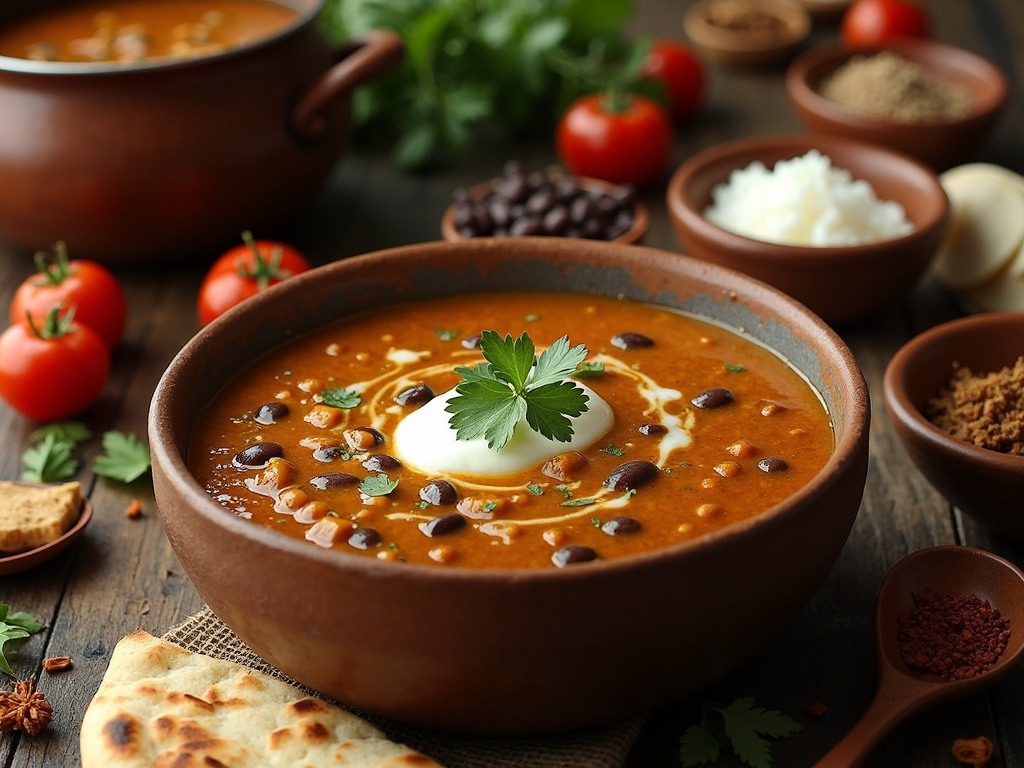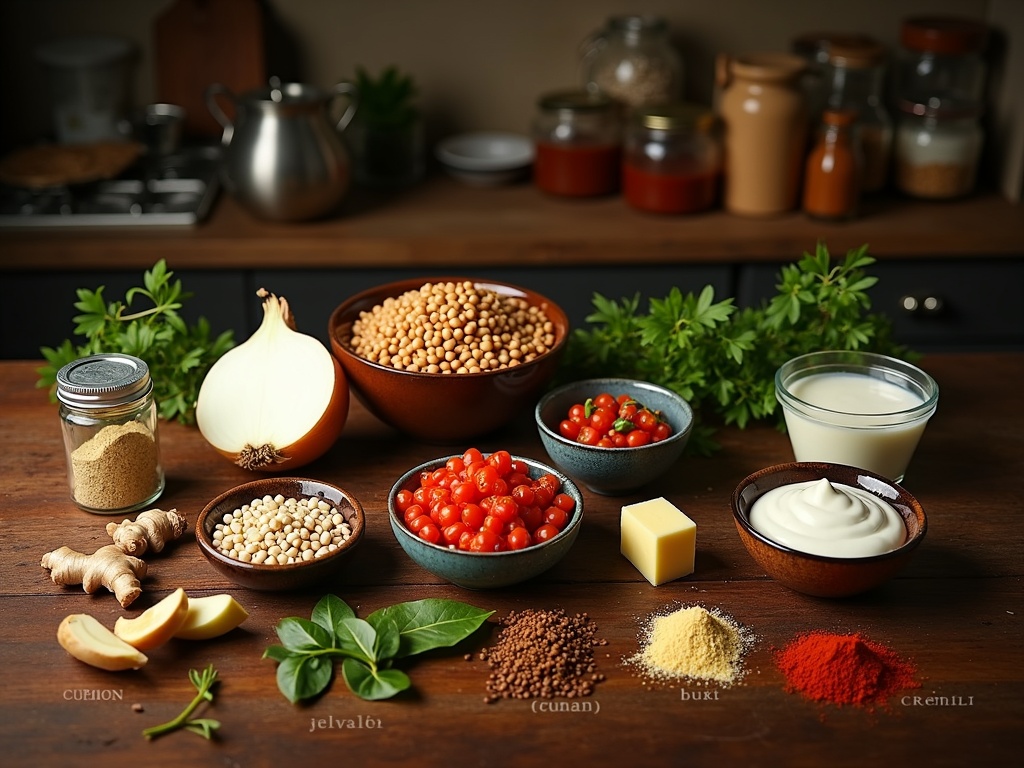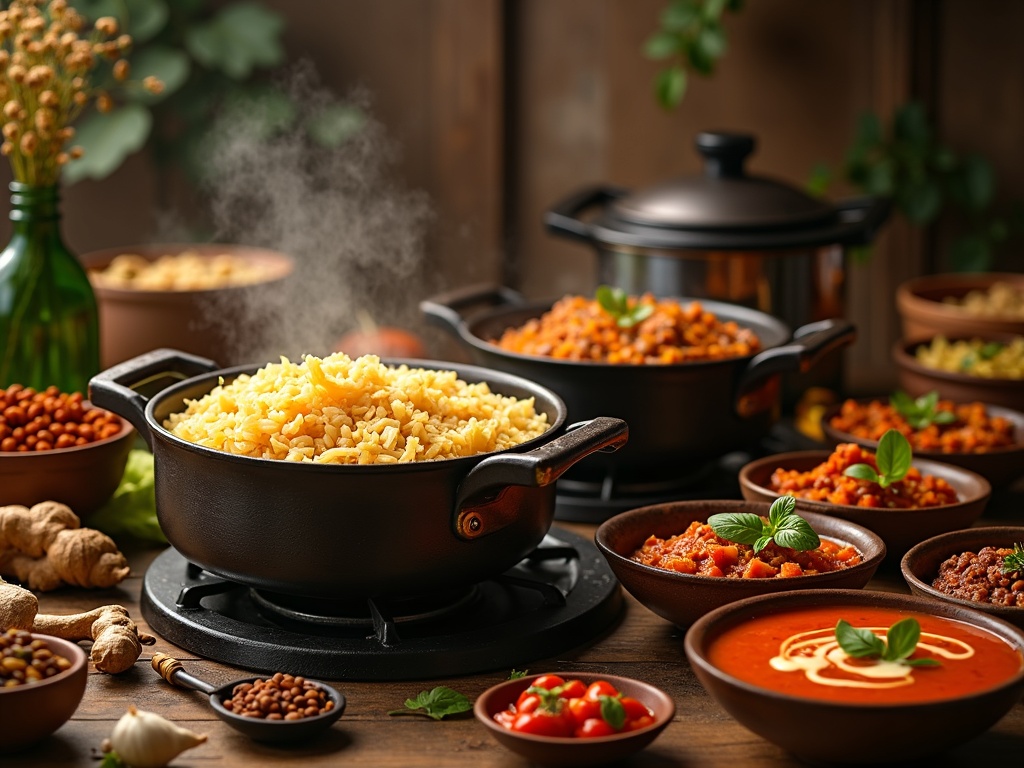Dal Makhani recipe, a beloved North Indian dish, transforms humble black lentils and kidney beans into a luxurious, creamy delicacy through its signature slow-cooking process. This protein-rich comfort food achieves its distinctive character through the perfect balance of butter, cream, and aromatic spices, requiring patience to develop its complex depth of flavor.
Find In This Article
Key Takeaways
- Traditional Dal Makhani combines whole black lentils (urad dal) and kidney beans (rajma), delivering 15-20 grams of protein per serving.
- The authentic preparation requires slow simmering for hours, allowing flavors to develop fully and creating the signature creamy consistency.
- The dish gets its richness from butter (makhan), fresh cream, tomatoes, and aromatic spices like garam masala and fenugreek leaves.
- A single serving (200-250g) contains 275-350 calories with 8-10g of fiber, making it nutritionally balanced despite its rich taste.
- Dal Makhani can be adapted for dietary preferences by substituting dairy with coconut cream or adding leafy greens for extra nutrition.
What Makes Dal Makhani So Special
Dal Makhani stands out as one of the most beloved dishes in North Indian cuisine. This rich, creamy concoction has captured hearts worldwide with its luxurious texture and complex flavor profile. I’ve found that understanding what makes this dish truly special helps elevate the cooking experience.
The Perfect Harmony of Ingredients and Technique
The magic of Dal Makhani begins with its fundamental ingredients – whole black lentils (urad dal) and kidney beans (rajma). These protein powerhouses form the backbone of the dish, delivering approximately 15-20 grams of protein per serving. This makes Dal Makhani not just delicious but incredibly nutritious too.
What truly separates Dal Makhani from other lentil dishes is its preparation method. The slow-cooking process is essential – not a shortcut in sight! Traditionally, the lentils and beans are simmered over a low flame for hours, sometimes overnight. This patient approach allows the flavors to develop fully and the lentils to break down into a creamy consistency.
The dish gets its signature richness from generous additions of:
- Butter (makhan) which gives the dish its name
- Fresh cream for silky smoothness
- Tomatoes for tanginess and depth
- Aromatic spices like garam masala, cumin, and coriander
- Fenugreek leaves for their distinctive earthy aroma
I’ve discovered that the key to authentic Dal Makhani lies in balancing these elements. Too much cream overpowers the earthy lentils, while insufficient slow-cooking leaves the dish lacking its signature depth.
The transformation that occurs during cooking is remarkable. What starts as humble lentils and beans evolves into a velvety, complex dish with layers of flavor that unfold with each spoonful. The spices don’t overwhelm but complement the natural earthiness of the lentils.
Dal Makhani’s versatility adds to its appeal. It pairs beautifully with various Indian breads like naan, roti, or paratha, and complements rice perfectly. For a complete meal experience, you might want to try serving it alongside a simple dahl recipe to appreciate the contrast between this luxurious dish and its simpler cousins.
Despite its indulgent reputation, Dal Makhani remains at heart a comfort food. It’s the dish that brings families together, features prominently at celebrations, and represents the soul of Punjabi cuisine. The warm, savory flavors create an immediate sense of satisfaction that few other dishes can match.
What I find most fascinating about Dal Makhani is how it transforms humble ingredients into something extraordinary. Through patient cooking and careful balancing of flavors, simple lentils become a dish worthy of the finest restaurants yet remain accessible enough for home cooking.
This special dish proves that sometimes the most satisfying culinary experiences come not from exotic ingredients but from giving common elements the time and attention they deserve to shine.

Essential Ingredients for Perfect Dal Makhani
Dal Makhani is a rich, creamy lentil dish that relies on specific ingredients to create its distinctive flavor and texture. I’ve found that gathering the right components before starting makes the cooking process much smoother.
Core Ingredients
The foundation of authentic Dal Makhani begins with 1 cup of whole black gram (black urad dal) and 1/4 cup of kidney beans (rajma). These lentils must be soaked for at least 8 hours before cooking – I typically soak them overnight to ensure they soften properly and cook evenly. This soaking step is non-negotiable as it significantly reduces cooking time and improves digestibility.
The richness that defines this dish comes from 4 tablespoons of unsalted butter and 1 cup of heavy cream. These dairy components create the silky, luxurious texture that gives Dal Makhani its name – “makhani” literally means buttery.
For the aromatic base, you’ll need:
- 1 medium onion, finely chopped
- 1-inch piece of ginger, freshly grated
- 4-5 garlic cloves, minced
- 2 green chilies, finely chopped
- 4 medium tomatoes, pureed
The tomato puree provides tanginess that balances the richness, while the onion-ginger-garlic mixture forms the flavor foundation. Green chilies add subtle heat that can be adjusted to your preference.
Spice Elements
The spice profile of Dal Makhani is fairly straightforward but essential for authentic flavor. I recommend keeping these spices on hand:
- 1 teaspoon cumin seeds
- 1 bay leaf
- 1 teaspoon garam masala
- 1/2 teaspoon red chili powder
- Salt to taste
The combination of these ingredients creates a harmonious blend that’s both comforting and indulgent. If you’re looking for other delicious lentil recipes, you might also enjoy trying a simple dahl recipe that uses different lentils for a lighter meal option.
When preparing Dal Makhani, I always recommend using fresh ingredients whenever possible, particularly for the aromatics like ginger, garlic, and green chilies. The quality of your butter and cream also makes a noticeable difference in the final dish’s flavor and richness.

Master the Cooking Process
The secret to perfect Dal Makhani lies in the cooking technique. I’ve found that breaking down the process into clear steps helps achieve that restaurant-quality creamy texture and depth of flavor every time.
Step-by-Step Cooking Method
First, I pressure cook the urad dal (black lentils) and rajma (kidney beans) for 12-15 minutes until they’re completely tender. This initial cooking ensures the legumes are soft enough to absorb all the rich flavors that follow.
In a separate heavy-bottomed pot, I melt butter and sauté finely chopped onions until they reach a beautiful golden color. This usually takes about 5-7 minutes on medium heat. The caramelization of onions forms a flavor foundation that can’t be rushed.
Next comes the aromatic blend – I add the ginger-garlic-chili mixture and cook it for 1-2 minutes until the raw smell disappears. This step releases essential oils from these ingredients, creating that distinctive Dal Makhani aroma.
The tomato puree needs careful attention – I cook it for 10-15 minutes until I see the oil separating around the edges. This indicates the tomatoes have been cooked properly and will give the dal its tangy depth.
Here’s where many home cooks miss the mark – the critical slow simmer. After adding the cooked lentils and beans to the masala:
- Simmer on low heat for 30-40 minutes, stirring occasionally
- Add water as needed to maintain consistency
- Mash some lentils against the side of the pot for creaminess
- Resist the urge to rush this stage – this is where the magic happens
The final consistency should be rich and creamy – not too thick or thin. I often finish with a splash of cream and a pat of butter right before serving to give it that signature velvety texture.
For an authentic dal makhani experience, I sometimes serve this with other dahl variations to create a complete lentil feast that showcases different regional flavors.
Remember, Dal Makhani gets even better the next day when the flavors have had time to meld together, making it a perfect make-ahead dish for special occasions.

Health Benefits and Nutrition Facts
Dal Makhani isn’t just a delicious dish; it’s packed with nutrients that make it a wholesome addition to any diet. I’ve found that understanding the nutritional profile of what I’m eating helps me make better food choices, especially when enjoying rich, flavorful dishes like this classic lentil preparation.
Caloric and Macronutrient Breakdown
A typical serving of Dal Makhani (about 200-250g) contains approximately 275-350 calories, making it a relatively moderate calorie option. The dish provides 35-40g of carbohydrates, primarily from the lentils, which serve as a slow-releasing energy source that keeps you fuller for longer. One of the standout nutritional aspects is its impressive fiber content—8-10g per serving—which supports digestive health and helps maintain steady blood sugar levels.
The protein content in Dal Makhani is particularly noteworthy. The combination of black lentils (urad dal) and kidney beans (rajma) creates a complete protein profile that’s beneficial for muscle maintenance and overall body function. This high protein content makes the dish particularly satisfying, helping to curb hunger between meals.
Nutritional Highlights
Dal Makhani offers several nutritional benefits that contribute to overall health:
- Rich in antioxidants from tomatoes, which help combat cellular damage and may reduce inflammation
- Contains healthy fats from cream and butter, providing essential fatty acids when consumed in moderation
- High in iron and zinc from the lentils, supporting oxygen transport in the blood and immune function
- Good source of folate, important for cell division and DNA synthesis
- Provides magnesium and potassium, essential minerals for nerve function and blood pressure regulation
The combination of spices used in Dal Makhani, such as cumin, coriander, and garam masala, aren’t just flavor enhancers—they also offer additional health benefits. Many of these spices have anti-inflammatory and digestive properties that complement the nutritional profile of the dish.
For those watching their fat intake, it’s worth noting that traditional Dal Makhani does contain butter and cream. However, I’ve found that these ingredients can be reduced or substituted with lighter alternatives without significantly compromising the dish’s character. The creamy texture can still be achieved with less butter and a smaller amount of cream, or even with yogurt for a tangier version.
If you’re looking to explore more nutritious lentil dishes, you might also enjoy a classic dahl recipe that offers similar nutritional benefits with different flavor profiles.
The balanced combination of proteins, complex carbohydrates, and essential nutrients makes Dal Makhani not just a comfort food but also a nutritionally sound meal option. When paired with a small portion of brown rice or whole grain roti, it creates a complete meal that provides sustained energy and satisfaction.
Creative Variations and Modern Twists
Dal Makhani is incredibly versatile, allowing for numerous adaptations while maintaining its soul-satisfying essence. I’ve experimented with several modifications that cater to different dietary needs and flavor preferences.
Plant-Based and Flavorful Alternatives
The traditional recipe can be easily transformed into a vegan delight without sacrificing its creamy texture. Simply swap butter and cream with vegetable oil and coconut cream. The coconut cream adds a subtle sweetness that complements the earthiness of the lentils beautifully. For an extra dimension of flavor, I like to add a teaspoon of garam masala or smoked paprika during the final stages of cooking – this creates a deeper, more complex taste profile that many find irresistible.
Adding leafy greens is another fantastic way to elevate this classic dish. Stirring in a handful of chopped spinach or kale about 5 minutes before serving not only boosts the nutritional value but also adds a pop of color. These greens wilt perfectly into the hot dal, becoming part of its rich tapestry of flavors.
For those who enjoy heat, adjusting the quantity of green chilies can transform the dish from mild to fiery. Start with:
- One green chili for a gentle warmth
- Two for a moderate kick
- Three or more for true spice enthusiasts
This dish adapts remarkably well to various dietary needs – whether you’re following a gluten-free, dairy-free, or low-fat eating plan. The protein-packed lentils make it a substantial meal on their own, though they pair wonderfully with rice or naan.
For more lentil inspiration, you might want to check out my dahl recipe that features different lentil varieties and cooking techniques.
The beauty of experimenting with Dal Makhani lies in its forgiving nature – it welcomes creative additions while maintaining its comforting character, making it perfect for both traditional meals and contemporary cooking.
Perfect Pairings and Serving Ideas
Dal makhani truly shines when paired with the right accompaniments. I’ve found that the rich, creamy texture of this beloved lentil dish creates the perfect foundation for various complementary flavors and textures.
Classic Accompaniments
Nothing completes a bowl of dal makhani quite like freshly made naan bread or fluffy basmati rice. The bread provides an excellent vehicle for scooping up the velvety lentils, while the rice absorbs the flavorful sauce. For an enhanced experience, I recommend serving a side of cooling raita alongside your dal makhani. This yogurt-based side dish offers a refreshing temperature contrast and helps balance the richness of the lentils.
Traditional Indian meals often include these accompaniments with dal makhani:
- Freshly made naan bread, slightly charred and brushed with ghee
- Perfectly cooked basmati rice with separated grains
- Cucumber raita with mint for cooling contrast
- Tangy Indian pickles (achaar) for a burst of flavor
- Sliced onions mixed with lemon juice and a sprinkle of salt
Presentation Tips
The final presentation of dal makhani makes a significant difference in the dining experience. I always finish my dal makhani with a generous swirl of fresh cream on top and a sprinkle of finely chopped fresh coriander leaves. This not only enhances the visual appeal but also adds layers of flavor.
For an authentic touch, serve your dal makhani piping hot with a small pool of melted butter or ghee visible on top. This creates that irresistible restaurant-quality finish that makes the dish even more enticing. The butter slowly melts into the lentils, creating a beautiful sheen and adding richness to every bite.
If you’re looking to create a complete Indian feast, consider adding other dahl varieties to your spread. The contrast between the rich dal makhani and lighter dal preparations creates a wonderful balance on the table.
Remember that dal makhani tastes even better the next day as the flavors deepen, making it perfect for preparing ahead for special gatherings or family meals.

Sources:
The Indian Culinary Institute – Dal Makhani: Traditional Indian Recipe
Nutrition Journal – Health Benefits of Lentils
Indian Food Network – Classic Indian Dishes: Ingredients and Preparation

